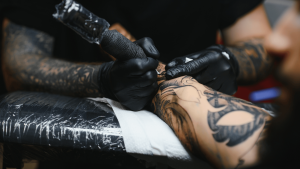For decades, the conversation around fine jewelry for men felt predictable. It was often limited to a wedding band, a dress watch, or perhaps an ID bracelet, pieces that were more utilitarian or ceremonial than expressions of personal style. The luxury space, particularly for everyday, intentional adornment, was an underserved market. Men who appreciated quality craftsmanship and subtle elegance often had to search to find pieces that transcended flash and spoke to a deeper sense of self. But something fundamental has shifted.
Today, there’s a quiet but powerful renaissance happening in the world of men’s accessories. The discerning man is no longer interested in ostentation; he’s seeking intention. He’s looking for pieces with heritage, meaning, and understated quality. In affluent communities where professionals value substance and longevity, local jewelers are noticing a distinct and growing demand for sophisticated, historically rich pieces. This shift represents a rejection of disposable trends and a return to the lasting, tactile quality of gold, silver, and precious stones.

The New Gold Standard: Why Sophisticated Men’s Fine Jewelry is Making a Serious Comeback
The Allure of Heritage: Why History Matters Now
The modern interest in men’s jewelry is deeply connected to a desire for permanence and a connection to history. In an era of rapid technological change and fleeting digital trends, the weight of a gold chain or the seal of a signet ring offers a grounding, tangible link to the past. These are items built to last generations, offering a sharp contrast to consumer goods designed for obsolescence.
When a man walks into a Beavercreek jewelry store today, he’s not just looking for a purchase; he’s seeking an investment in personal identity. This is why pieces with a demonstrable history and cultural significance, like the signet ring, are leading the charge. They are not merely decoration; they are personal artifacts.
The Signet: A History Worn on the Hand
The signet ring is arguably the most powerful symbol of this resurgence. Its history is long and prestigious, dating back to 3500 BC in Mesopotamia, where cylindrical seals were used to mark authenticity. The ancient Egyptians attached these seals to rings, and Pharaohs wore them as a sign of authority. Later, throughout the Middle Ages, the signet ring became essential for nobility, used to stamp and seal documents with a family crest. This was the equivalent of a signature, or even a fingerprint, and upon the owner’s death, the ring was often destroyed to prevent forgery.
This profound, functional history is exactly what makes the signet so appealing today. It is an heirloom in waiting. Modern styles have moved beyond the strictly traditional family crest, embracing initials, geometric patterns, or a clean, unadorned surface, often set with a polished semi-precious stone like onyx, lapis lazuli, or bloodstone.
The key to wearing a signet ring with modern sophistication is balancing the proportion and the intention. This is where the guidance of an experienced jeweler becomes crucial. The piece must feel right, both visually and physically.
Proportion and Placement: Wearing the Signet Ring Right
- • Size and Feel: The face of the ring should be proportionate to the wearer’s hand and finger size. Too large, and it becomes a statement of excess; too small, and it looks lost. The right fit ensures it feels balanced and comfortable for daily wear.
- • Finger Placement: Historically worn on the little (pinky) finger or the ring finger (non-wedding hand), modern rules are more flexible. Wearing it on the index finger is a bold statement, but the pinky maintains a classic, subtle elegance that appeals to men who favor quiet luxury and tradition.
- • Intentional Design: Choose a design that reflects a real aspect of your life—an initial, a birthstone, or a personal symbol. It should feel like a piece of personal history, not merely a decorative object. Simplicity often speaks the loudest, allowing the metal and the history to do the talking.
The most popular material choices remain the classics: weighty 14k or 18k yellow gold for warmth and tradition, or cool, solid platinum or white gold for a subtle metallic sheen that pairs well with contemporary clothing.
Chain Reaction: Understanding the New Neckwear
For men, a necklace is a complex piece of jewelry. For years, the popular imagination was dominated by extremes: either the extremely thin, almost invisible chain, or the excessively thick, highly polished variety. The current moment calls for something in the middle—a chain that feels substantial, drapes beautifully, and offers textural interest without demanding excessive attention.
The chain is a foundational piece in the new men’s jewelry landscape, and understanding the difference between the classic styles is essential to choosing one that will endure. It’s a piece that can often be worn beneath a shirt, offering a private confidence only the wearer knows, or worn openly to anchor an otherwise simple outfit.
The Three Enduring Styles of Men’s Chains
- The Curb Chain: This is perhaps the most recognizable style. It features interlocking, uniform links that are twisted flat, sitting flush against the skin, offering a smooth, classic drape. When worn in a medium weight (around 3mm to 5mm), the curb chain is versatile enough to be worn alone for a clean look or paired with a subtle pendant. Its strength and simple architecture make it a durable everyday choice.
- The Cuban Link: A close cousin of the curb, the Cuban link is characterized by thicker, rounder links that are tightly interlocked. This style has a distinctly substantial and masculine profile, especially when crafted in solid gold. Due to its inherent thickness and weight, the Cuban link often works best as a standalone statement, requiring no pendant to complete the look.
- The Figaro Chain: The Figaro offers visual rhythm and interest, making it slightly more decorative than the curb or Cuban. It uses a repeating pattern, typically featuring two or three smaller links followed by one elongated link. This variation breaks up the uniformity of the metal and catches the light differently, lending a unique, almost woven texture to the wearer’s silhouette.
When it comes to neckwear, the current preference leans toward shorter lengths, typically 18 to 20 inches, that sit right at or just below the collarbone. This length allows the chain to be layered subtly beneath a buttoned shirt or to be seen peeking out of the neck opening of a crewneck or polo, achieving that desired look of quiet sophistication.
Wearing With Intention, Not Ostentation
The biggest difference between wearing jewelry with intention and wearing it with ostentation comes down to balance and quality. Intentionality means choosing pieces that complement, rather than dominate, the rest of one’s attire. It means selecting a chain weight that feels substantial but doesn’t distract. It means having one excellent signet ring instead of multiple flashy ones.
The intention is demonstrated in the details: matching the metal of a bracelet or ring to the hardware on a watch, or ensuring that layered necklaces vary slightly in length and texture. If a man is wearing a chain and a bracelet, for instance, the combination should feel harmonious, perhaps a heavy gauge curb chain on the neck and a simple, polished bangle on the wrist opposite the watch, maintaining a deliberate asymmetry. The goal is coordination, not competition.
A man focused on quality is investing in the feel of the piece on his skin, the permanence of the material, and the detail of the craftsmanship. The decision to buy a piece of fine jewelry should be driven by a desire for a lifetime piece that tells a silent story about the wearer. This investment is personal and private, not meant for public showmanship.
The Value of Local Expertise
Finding the right piece often starts with visiting a trusted Beavercreek jewelry store. While large national retailers offer convenience, the specialized, local jewelers often provide the in-depth expertise needed to source or custom design a truly meaningful piece. They can explain why the specific gravity of solid gold feels different from a lighter, machine-made piece, or why the hand-engraving on a signet ring holds its detail better than a mass-produced casting.
Many local shops offer custom design services that cater directly to the man seeking a piece with true personal significance. Whether it is repurposing a family stone into a new signet ring or crafting a chain with a specific, comfortable weight, this level of personalization cannot be replicated in a standard retail environment. The focus should always be on what is enduring and authentic, and that authenticity often begins with the person who crafted or selected the piece. For the discerning customer, the advice from a reputable Beavercreek jewelry store is an essential part of the investment.
Beyond the Basics: Details That Elevate the Collection
Jewelry for men extends beyond rings and chains into accessories that bridge utility and style. Pieces like high quality cuff links, expertly engraved tie bars, and subtly textured bracelets are also part of this sophisticated wave.
The common denominator across all these pieces is a commitment to quality over quantity. Instead of owning a drawer full of inexpensive, plated, or trendy items, the new approach is to own a small, curated collection of solid gold, sterling silver, or platinum items, pieces that can be worn daily without worry of tarnishing or breaking, and that improve with the patina of time and wear. They become extensions of the self, quietly communicating a commitment to craftsmanship and enduring value.
This focus on subtle, lasting luxury explains why the market for serious men’s accessories is thriving. It’s a move toward permanent style, where every accessory is chosen with purpose, reflecting the wearer’s journey and his place in the world. It’s a return to the history and elegance of true adornment, a practice that is anything but new, but feels profoundly relevant today. The modern man is not buying; he is collecting, and the difference is all in the intention.
Shikha Negi is a Content Writer at ztudium with expertise in writing and proofreading content. Having created more than 500 articles encompassing a diverse range of educational topics, from breaking news to in-depth analysis and long-form content, Shikha has a deep understanding of emerging trends in business, technology (including AI, blockchain, and the metaverse), and societal shifts, As the author at Sarvgyan News, Shikha has demonstrated expertise in crafting engaging and informative content tailored for various audiences, including students, educators, and professionals.











